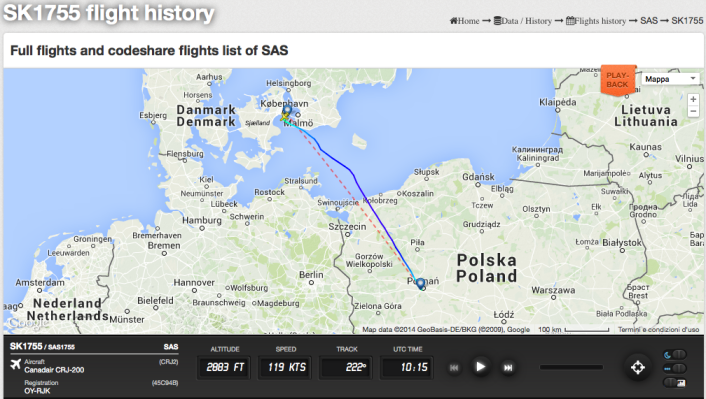Russian planes that operate close to airspaces of northern European countries pose a threat to civil aviation.
A civil plane, en route from Denmark to Poland, almost collided with a Russian spyplane minutes after departure, Swedish authorities said on Friday.
The Russian aircraft was flying with the transponder turned off; the Swedish Air Force scrambled its JAS-39 Gripen jets to intercept and escort the “intruder”, that they identified as an intelligence gathering type (most probably an Il-20 Coot).
According to Flightradar24.com, the flight involved in the near-miss was SK1755, a Canadair CRJ-200 (registration OY-RJK) from Cimber Airlines departed from Copenhagen, with destination Poznan.
Based on the analysis of the ADS-B data they collected, the dangerous close encounter occurred about halfway between Ystad, Sweden and Sassnitz, Germany, between 11:21 CET and 11:25 CET.
Here’s how the incident developed:
11:18: SK1755 got permission to climb to 25,000 feet
11:21: SK1755 urged to stop the climb at 21,000 feet due military traffic between 23,000 and 25,000 feet.
11:23 SK1755 advised to turn right to avoid military traffic.
11:24 SK1755 reached 21,000 feet and stopped climbing.
11:24 SK1755 passed just behind the military plane and then allowed to continue the climb.
At this link you can see the Sk1755 turn to the right to avoid the collision and stop climbing to 21,000 feet. Obviously, you can’t see the Russian plane, as it was flying, in international airspace, with the transponder turned off, hence invisible to civilian radars.
Image credit: Flightradar24.com
The near collision comes in a period of intense Russian Air Force activity in the Baltics; a surge in missions that are flown without FPL (Flight Plan) nor transponders (sometimes to probe local air defenses readiness) that may pose a threat to civilian traffic in the region.
On Mar. 3, SAS flight SK 681, a Boeing 737 with 132 people on board from Copenhagen to Rome almost collided with an Il-20 Coot, about 50 miles to the southwest of Malmö, Sweden. Thanks to the good visibility, the SAS pilot could avoid the Russian SIGINT (Signal Intelligence) aircraft:the two planes passed 90 meters apart.
Russian Air Force bombers, including Tu-95s, Tu-22s, Su-34s escorted by MiG-31s and Su-27s, as well as Il-20s regularly fly in the Scandinavian region causing alert scrambles by NATO planes providing QRA (Quick Reaction Alert) for the Baltic Air Policing mission.
Top image credit: French Air Force

















